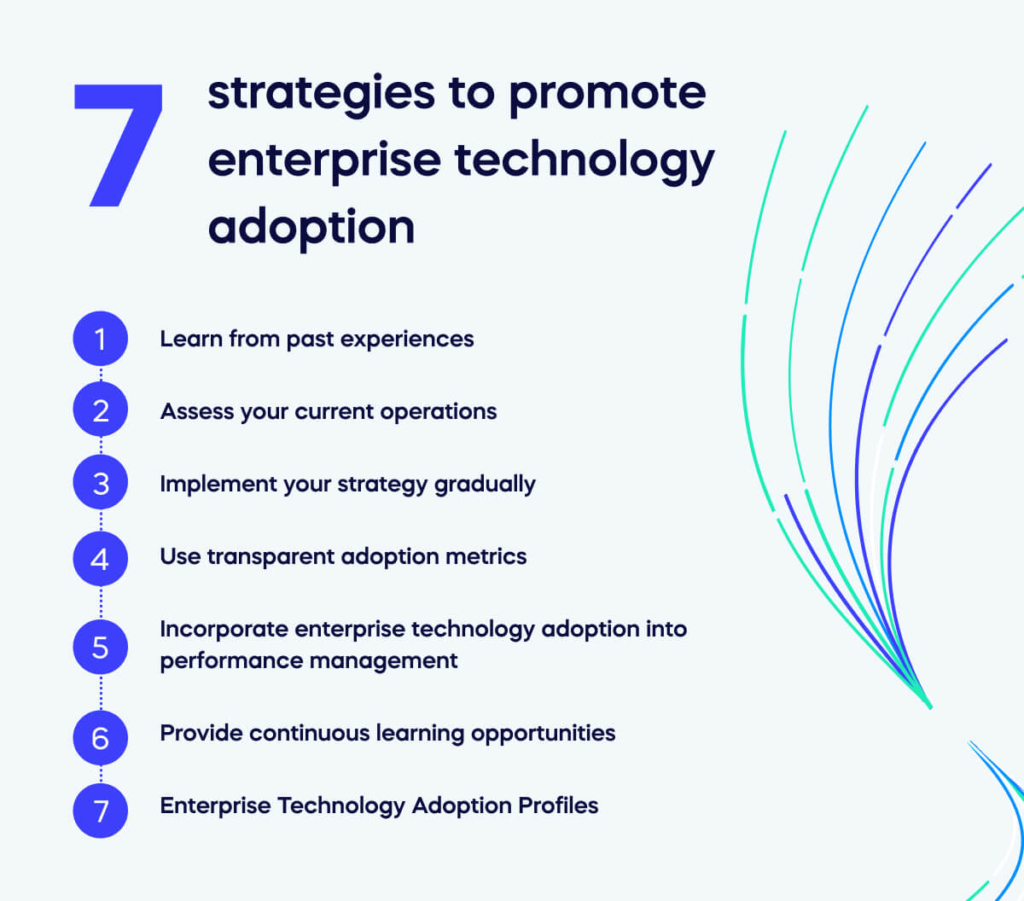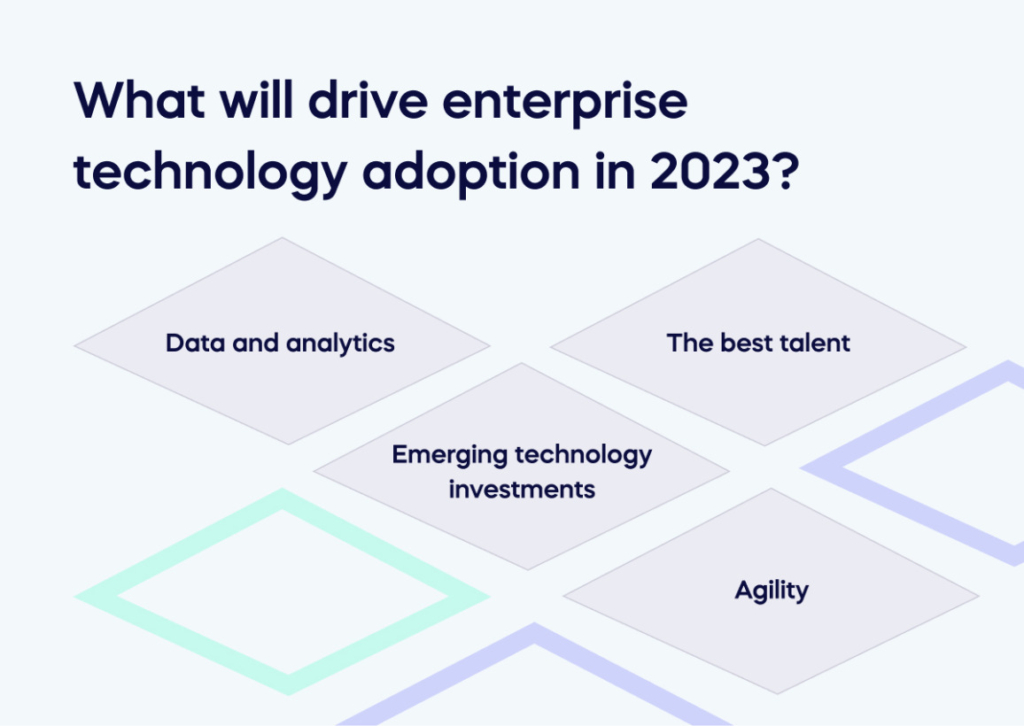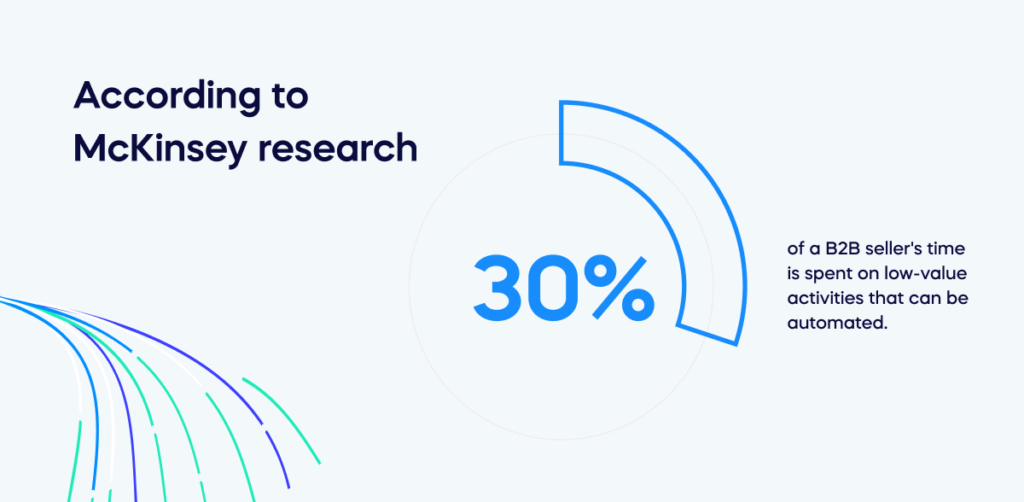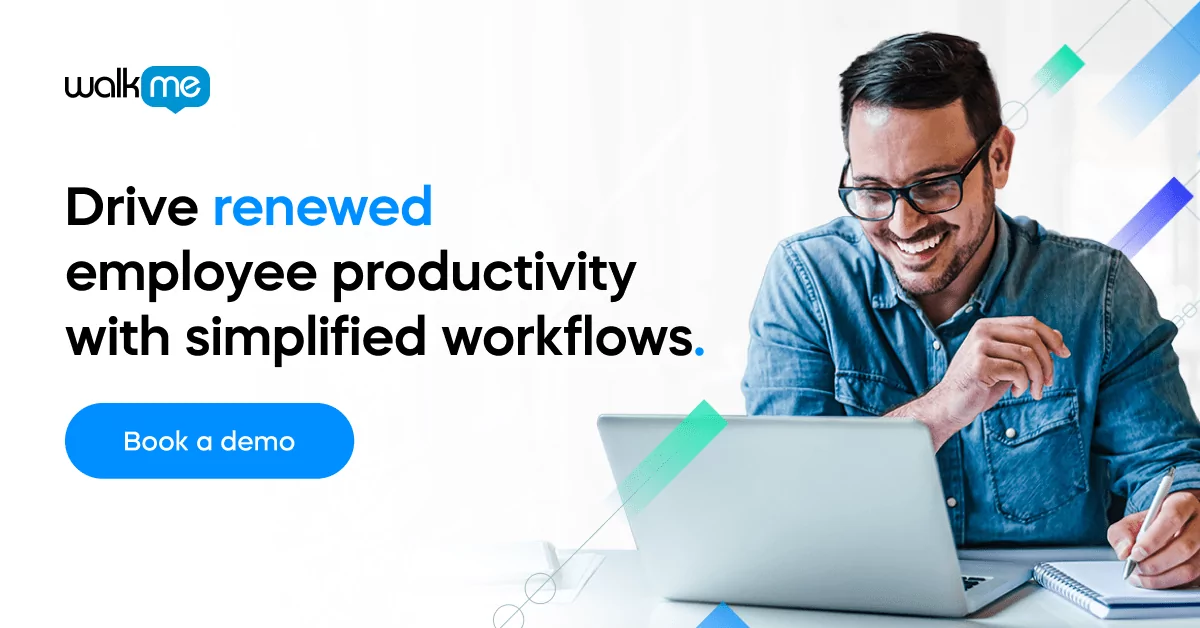Technology adoption is hard enough for smaller companies, let alone organizations with thousands of staff.
For larger enterprises, it can feel like a near-impossible task due to the different attitudes and concerns of different roles toward new technologies.
This is the scenario in which enterprise technology adoption exists, delivered by customer lifecycle technology platforms, which help users adopt new tech efficiently through excellent customer adoption of new technologies.
With each vendor offering emerging technologies like generative AI creating further business pressures to invest in the early stages of the life cycle of new solutions, adopting technology early pays dividends.
To help you understand enterprise technology adoption, we will explore the following topics:
- What factors impact enterprise technology adoption?
- Strategies to promote enterprise technology adoption?
- What technologies will drive enterprise technology adoption in 2023?
What factors impact enterprise technology adoption?
Amid the initial two years of the COVID-19 pandemic, the enterprise tech sector experienced a massive surge in growth due to the rapid shift towards digital transformation.
Small and large businesses were keen on facilitating and expediting their digital progress. This led them to seek subscription, as-a-service, and cloud-based products with an unparalleled sense of urgency.
B2B technology clients now prioritize expertise when buying products and solutions. Instead of relying on tech sales teams, they need more comprehensive aid in driving and directing their digital transformations.
Enterprise sales teams are now expected to have technical expertise, industry knowledge, and the ability to provide integrated solutions. B2B clients are no longer satisfied with a single point of contact and involve multiple stakeholders in their buying decisions. Expertise is now valued more than other factors.
Businesses today want easy and personalized self-service experiences when browsing new technologies for their organization, similar to what consumers get when shopping online for groceries, clothes, or used cars.
McKinsey research indicates that over 30% of B2B customers use digital and self-service channels throughout the buying process. This experience has become possible due to the rise of cloud-based, easy-to-re deploy solutions.
How the COVID-19 pandemic has impacted enterprise technology adoption is significant in how B2B clients now purchase and adopt new technologies and is essential to success in 2023.
7 strategies to promote enterprise technology adoption

These six strategies will help you promote enterprise technology adoption effectively and efficiently.
1. Learn from past experiences
Reflect on previous efforts to manage organizational change. Identify successful and unsuccessful aspects and use those insights to modify your current approach.
For instance, uncover why and how the team completed necessary tasks if a previous tool lost popularity over time. The goal is not to create new details but to enhance clarity.
2. Assess your current operations
It is essential to understand your team’s current workflows and processes to effectively introduce your new enterprise technology and explain its benefits, such as simplified updates.
What is the process for performing the task? Can you describe the tools you use for the task? Are there any workarounds you use? Do you perform the same task across multiple tools?
Involve your team in the tool evaluation and selection process. For instance, if you decide between two providers offering technologies, you can demonstrate how each tool works and ask your team for feedback. This way, they can visualize and comprehend your plan better.
3. Implement your strategy gradually
To ease the process change, create a phased rollout plan with milestones. This will allow the team to adjust, ask questions, and give feedback before introducing more changes to the process.
Please carefully consider the milestones in migrating from one process and system to another. It may be helpful to use a phased approach, such as starting slowly and gradually building up to full implementation and assessing the number of processes or tasks that need to be migrated.
Arrange the processes and tasks according to difficulty, starting from the easiest to the most difficult, and set your milestones based on the rankings. It’s important to note that using two systems simultaneously can be challenging, so ensure to provide regular reminders to the team regarding what needs to be done, when it needs to be done, and which system to use.
4. Use transparent adoption metrics
It’s always helpful to provide an update during weekly team meetings on the change’s adoption level.
Migrating processes from the old system can measure this metric to the new one or the number of tasks completed using the new system. Next, track and share the percentage of the team that has adopted the change.
The aim is not publicly calling out individuals but demonstrating to the team that they are progressing. Gamifying this exercise as a bit of friendly competition could motivate team members to encourage each other to complete the task to a high standard.
5. Incorporate enterprise technology adoption into performance management
If you consider a fundamental behavior change necessary for your future, you can include it in the performance evaluation process.
It’s important to remember that performance evaluations should not include adopting the enterprise technology solution right after its implementation. It’s necessary to give the team time to adjust and learn how to use the change.
Review your current performance improvement and evaluation periods and choose a future evaluation period to set goals for individuals based on their performance in a specific category, which will help ensure the long-term adoption of the solution.
To better assess performance, use the current evaluation period as a learning phase and wait until the next period to start evaluations officially.
You can create a category named “Productivity Tools” or “Technology Alignment” that includes tool usage and other significant areas such as QBR completions, account contacts, and timeline tracking.
6. Provide continuous learning opportunities
Choose a coach from your team who will train and provide individual support as required. If you are implementing a gradual plan with specific goals, consider setting up checkpoints every two weeks after each milestone.
During the checkpoints, request your coach to gather feedback from individuals through surveys or interviews regarding the rollout process.
The input should cover questions related to the ease of use and clarity of the process, which can identify areas that require more training, coaching, or communication.
Creating designated office hours can facilitate receiving feedback in a comfortable environment and allow for impromptu Q&A sessions.
Use the input gathered to enhance and document your training in a Learning Management System (LMS), which can benefit current and new hires by providing ongoing training and development opportunities.
7. Enterprise Technology Adoption Profiles
Gartner provides enterprise technology adoption (ETA) profiles to help enterprises to help guide enterprises in the way they plan, control, and adjust the speed of change of their technology-related choices.
The characteristics of the enterprise technology adoption profiles are as follows:
- Gartner created the ETA Profiles by carefully analyzing over 10,000 enterprises, including government organizations.
- ETA Profiles evaluate businesses on three axes: Pace of change, technology planning, and control.
- There are seven ETA Profiles businesses within a cluster, which may differ somewhat across each characteristic.
- ETA Profiles are more effective than traditional firmographics like industry, country, or business size when predicting technology purchasing patterns.
Before pushing for a significant change that goes against your ETA Profile, ensure you have the endorsement of your leaders and anticipate any obstacles you may encounter.
ETA Profiles can help you comprehend the technological background of your organization, business associates, or clients and how it influences technology-related initiatives.
What will drive enterprise technology adoption in 2023?

To support this new evolution in enterprise technology adoption in 2023, tech companies should consider investing in four primary enablers.
Data and analytics
Companies can invest more in data and analytics to improve lead generation and segmentation.
They can use this data to create “health models” for customers that detect potential opportunities and risks and then take needed actions throughout the go-to-market (GTM) process. Successful companies are developing data systems to gain insight into their customers and partners.
They then use this information to create “revenue operations” (RevOps) teams that bring together sales, marketing, and customer success to get a complete view of the customer.
Emerging technology investments
According to McKinsey research (linked above), over 30% of a B2B seller’s time is spent on low-value activities that can be automated.

This inefficiency is being tackled by some vendors who have introduced sales and RevOps (revenue operations) tools, leading to a 20% annual growth in the sales enablement software market.
However, top-performing companies don’t necessarily need more tools; they simplify workflows by using these tools and consolidate data sources to increase adoption at scale while focusing on user design.
The best talent
Companies require employees with specific skills such as industry expertise, customer service, strategic advisory, and sales analytics to implement a new approach to enterprise technology adoption successfully.
Leaders are focused on hiring individuals with relevant industry knowledge and are exploring new sources of talent.
They also invest in early-career programs and adopt modern training approaches to enhance sales capabilities.
Additionally, as employees value innovation, culture, purpose, flexibility, and inclusion, leaders evaluate and improve their talent offerings to appeal to desirable candidates.
Agility
To provide expertise and simplicity, building cross-functional teams that collaborate throughout the customer journey is essential. This requires new working methods, shared metrics, and composable business architectures.
Some companies are restructuring their leadership to promote collaboration. For example, one company may have a chief revenue officer responsible for sales and marketing, while a chief customer officer oversees customer-facing functions like CS, support, and services.
Use a DAP to optimize your enterprise technology adoption
The successful adoption of emerging technologies has become increasingly a priority for organizations seeking to remain competitive and maintain digital resilience.
Ultimately, the success or failure of an enterprise’s adoption rates is determined by numerous factors, from market forces to organizational predecessors.
Nevertheless, strategic utilization of a Digital Adoption Platform (DAP) can help speed up the learning curve for employees while ensuring that they understand and implement new technology efficiently.
Get ready and start planning now, as your organization should be well-prepared with a comprehensive strategy for effectively incorporating and adopting new and emerging tech.
Utilize this strategy with a DAP to optimize your enterprise’s tech adoption!


